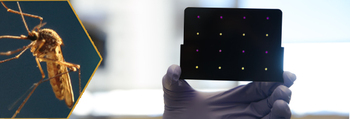In early May, a rapid, low-cost, freeze-dried, paper-based, strain-specific diagnostic system for detection of the Zika virus was introduced by an international consortium of researchers led by synthetic biologist James Collins of Harvard's Wyss Institute for Biologically Inspired Engineering. It could soon be used in the field to screen blood, urine or saliva samples.
The core of the test kit is a piece of paper that changes color in the presence of Zika virus RNA and produces results in two to three hours, much faster than the PCR test now used, according to Collins, a Wyss Core Faculty member, and Termeer Professor of Medical Engineering & Science and Professor of Biological Engineering at MIT. University of Toronto biochemist Keith Pardee adds that it should cost less than a dollar per test.
The team from a number of different institutions came together, and, in a matter of six weeks, developed the new approach to detection and designed a system to deploy in the face of future pandemics. In response to an emerging outbreak, Collins claims, a custom tailored diagnostic system could be ready for use within one week's time.
All components of the diagnostic system can be freeze-dried for storage and transport while retaining their efficacy. The ability to pinpoint a strain-specific diagnosis in the field could prove valuable to national and global health organizations for tracking the spread of a viral outbreak in real time and for preparing containment strategies and treatment plans.
The work by collaborators from the Wyss Institute, Massachusetts Institute of Technology (MIT), the Broad Institute, Cornell, Arizona State, University of Wisconsin-Madison, Boston University, and Addgene, was described in the May 6 issue of the journal Cell.
In this 53-minute podcast, I speak with Collins and Pardee about how a crisis can incite collaboration and innovation. We explore how they did it, what they learned, and what this might mean for the future.
Listen and subscribe to Disruptive on Soundcloud, iTunes, and Google Play.

